Inbox and Environment News: Issue 399
March 31 - April 6, 2019: Issue 399
Mona Vale Dunes Bushcare
There is a brand new Facebook page for Mona Vale Dunes Bushcare where you can keep up to date with progress and find out how to get involved. Visit: www.facebook.com/Mona-Vale-Dunes-Bushcare
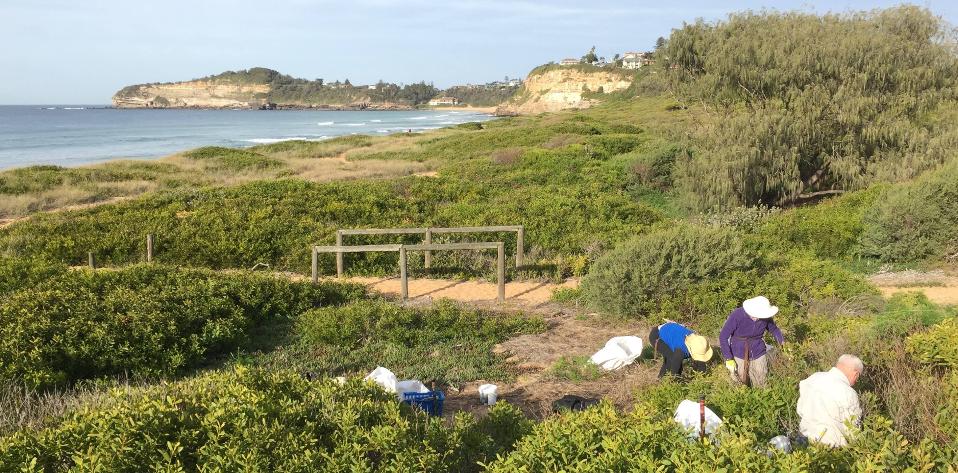
Here is Mona Vale Dunes bushcare group at work.
To suit most of us, we meet on two days of the month, so people come on either the second Saturday morning and the third Thursday - sometimes both!
With a view like this, you can see why we love this place. Our morning teas are legendary, by the way.
This photo may be from the 1970s and shows the dunes dangerously exposed to wind erosion, with not even today's dense weeds to stabilise it. Buildings on left are at end of Golf Ave.


View over dunes in 1969 from balcony at beach end of Golf Ave. We are lucky the destruction stopped when it did.We need our coastal dunes well vegetated and stabilised.


Danina with her Asparagus Fern crown. Probably our worst weed, it's on Australia's list of Weeds of National Significance (WoNS). We can see why. A great feeling when you finally get out that crown. The white water tubers are only for water storage and can stay behind.
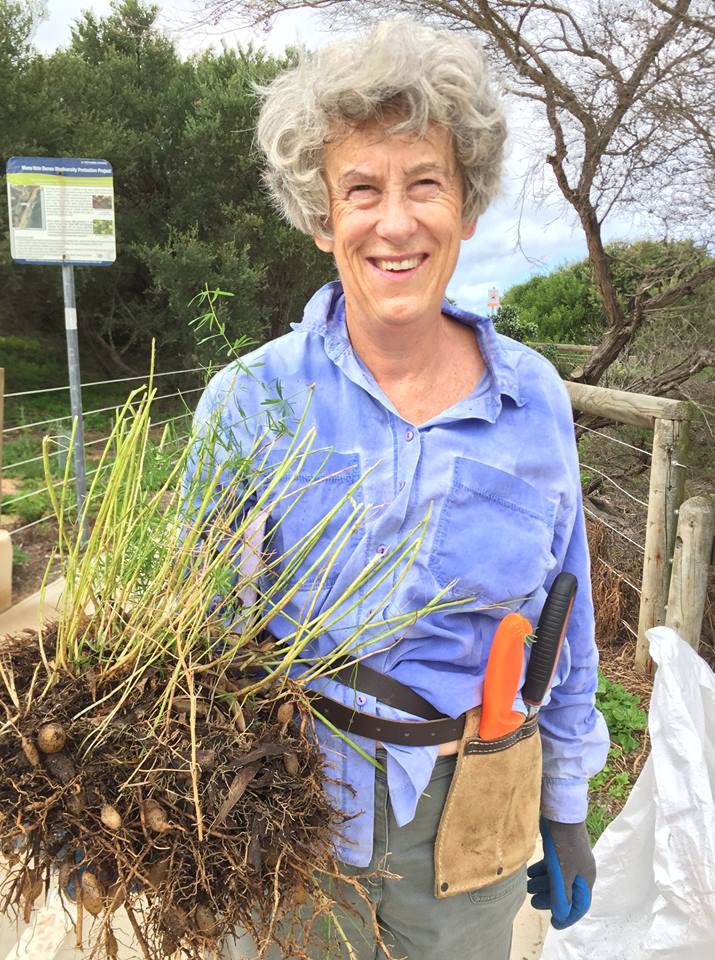

Mona Vale Dunes - birds' eye view. Golf Avenue is our usual entry point, at top right of image.
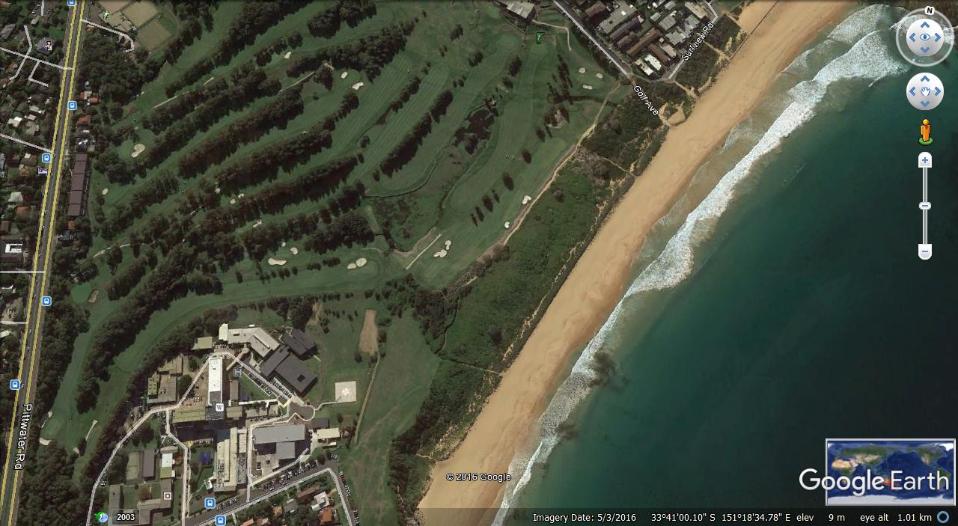
Our Profile picture is Beach Correa, Correa alba. This lovely little shrub flowers for most of the year, happy in wind and salty spray, a great dune stabiliser.


Mona Vale Dunes covers over 8 ha of our Sydney Northern Beaches coastline. The dunes and bushland have been nearly lost in the past to weeds like lantana and asparagus fern, and to sand removal. Much remains under dense weed, but with steady weeding and some planting of tubestock native plants, the northern area is recovering, and is a home for birds and other animals.
Sonic Sea Screening: Cremorne
Monday at 6:30 PM – 8:30 PM
Hayden Orpheum Picture Palace
380 Military Rd, Cremorne
Screening of the documentary of Sonic Sea and discussion panel at the Cremorne Orpheum Sydney
Please join us to see this award winning documentary about the beautiful symphony that is life underwater.
As 1000sq km of seismic blasting is planned for NSW to find the best drilling targets for an oil or gas field, this film is most relevant.
A collaborative event by Living Ocean and Save Our Coast.
Please join us to learn what you can do to save our oceans and keep the waters from Sydney to Port Stephens pristine and natural.
TO COINCIDE WITH UPCOMING FEDERAL ELECTIONS
YOUR CHOICE IS THE OCEANS FUTURE
*Please book asap to secure seating...link above.

More Fish, More Fishing: Why Strategic Marine Park Placement Is A Win-Win
March 26, 201
Australia has some of the most spectacular marine ecosystems on the planet – including, of course, the world-famous Great Barrier Reef. Many of these places are safe in protected areas, and support a myriad of leisure activities such as recreational fishing, diving and surfing. No wonder eight in ten Aussies live near the beach.
Yet threats to marine ecosystems are becoming more intense and widespread the world over. New maps show that only 13% of the oceans are still truly wild. Industrial fishing now covers an area four times that of agriculture, including the farthest reaches of international waters. Marine protected areas that restrict harmful activities are some of the last places where marine species can escape. They also support healthy fisheries and increase the ability of coral reefs to resist bleaching.
One hundred and ninety-six nations, including Australia, agreed to international conservation targets under the United Nations Convention on Biological Diversity. One target calls for nations to protect at least 10% of the world’s oceans. An important but often overlooked aspect of this target is the requirement to protect a portion of each of Earth’s unique marine ecosystems.
How are we tracking?
The world is on course to achieve the 10% target by 2020, with more than 7.5% of the ocean already protected. However, our research shows that many marine protected areas are located poorly, leaving many ecosystems underprotected or not protected at all.
What’s more, this inefficient placement of marine parks has an unnecessary impact on fishers. While marine reserves typically improve fisheries’ profitability in the long run, they need to be placed in the most effective locations.
We found that since 1982, the year nations first agreed on international conservation targets, an area of the ocean almost three times the size of Australia has been designated as protected areas in national waters. This is an impressive 20-fold increase on the amount of protection that was in place beforehand.
But when we looked at specific marine ecosystems, we found that half of them fall short of the target level of protection, and that ten ecosystems are entirely unprotected. For example, the Guinea Current off the tropical West African coast has no marine protected areas, and thus nowhere for its wildlife to exist free from human pressure. Other unprotected ecosystems include the Malvinas Current off the southeast coast of South America, Southeast Madagascar, and the North Pacific Transitional off Canada’s west coast.
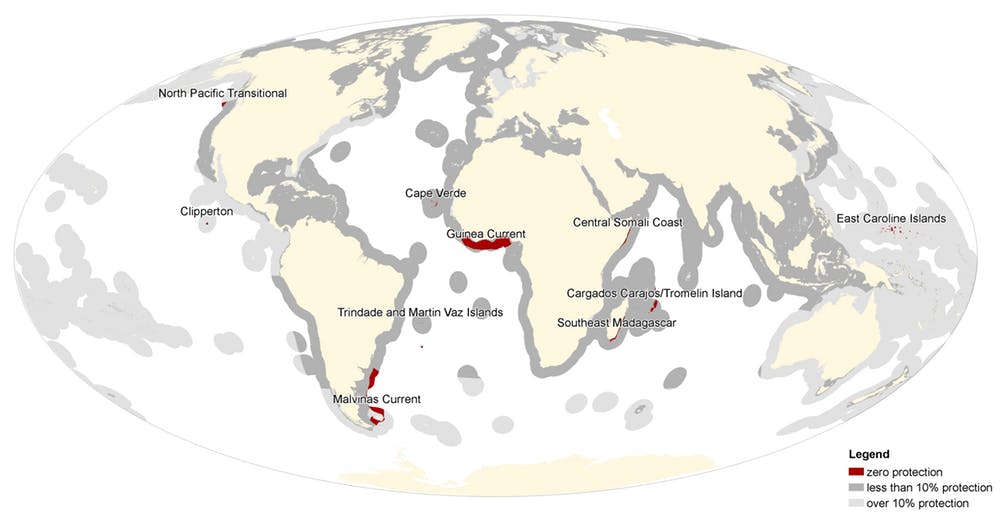
Marine park coverage of global ecosystems. Light grey: more than 10% protection; dark grey: less than 10% protection; red: zero protection. Author provided
Australia performs comparatively well, with more than 3 million square km of marine reserves covering 41% of its national waters. Australia’s Coral Sea Marine Park is one of the largest marine protected areas in the world, at 1 million km². However, a recent study by our research group found that several unique ecosystems in Australia’s northern and eastern waters are lacking protection.
Furthermore, the federal government’s plan to halve the area of strict “no-take” protection inside marine parks does not bode well for the future.
How much better can we do?
To assess the scope for improvement to the world’s marine parks, we predicted how the protected area network could have been expanded from 1982.
With a bit more strategic planning since 1982, the world would only need to conserve 10% of national waters to protect all marine ecosystems at the 10% level. If we had planned strategically from as recently as 2011, we would only need to conserve 13% of national waters. If we plan strategically from now on, we will need to protect more than 16% of national waters.
If nations had planned strategically since 1982, the world’s marine protected area network could be a third smaller than today, cost half as much, and still meet the international target of protecting 10% of every ecosystem. In other words, we could have much more comprehensive and less costly marine protection today if planning had been more strategic over the past few decades.
The lack of strategic planning in previous marine park expansions is a lost opportunity for conservation. We could have met international conservation targets long ago, with far lower costs to people - measured in terms of a short-term loss of fishing catch inside new protected areas.
This is not to discount the progress made in marine conservation over the past three decades. The massive increase of marine protected areas, from a few sites in 1982, to more than 3 million km² today, is one of Australia’s greatest conservation success stories. However, it is important to recognise where we could have done better, so we can improve in the future.
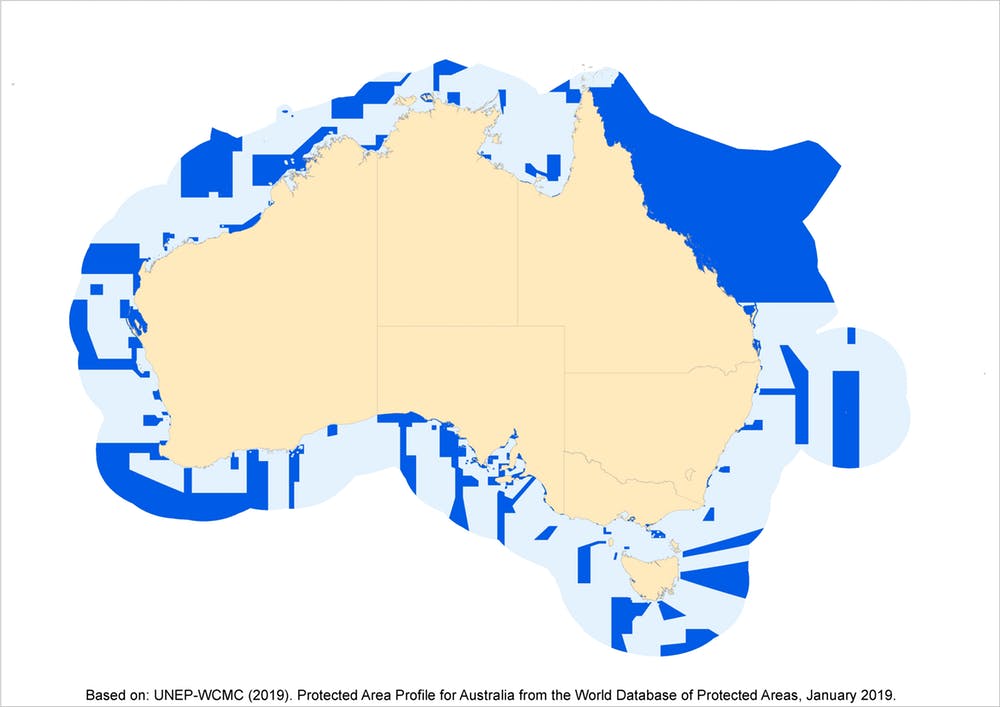
Australia’s marine park network. Author provided
This is also not to discount protected areas. They are important but can be placed better. Furthermore, long-term increases in fish populations often outweigh the short-term cost to fisheries of no-take protected areas.
Two steps to get back on track
In 2020, nations will negotiate new conservation targets for 2020-30 at a UN summit in China. Targets are expected to increase above the current 10% of every nation’s marine area.
We urge governments to rigorously assess their progress towards conservation targets so far. When the targets increase, we suggest they take a tactical approach from the outset. This will deliver better outcomes for nature conservation, and have less short-term impact on the fishing industry.
Read more: More than 1,200 scientists urge rethink on Australia's marine park plans
Strategic planning is only one prerequisite for marine protected areas to effectively protect unique and threatened species, habitats and ecosystems. Governments also need to ensure protected areas are well funded and properly managed.
These steps will give protected areas the best shot at halting the threats driving species to extinction and ecosystems to collapse. It also means these incredible places will remain available for us and future generations to enjoy.
This article was published first in The Conversation and can be read, including all links, here - republished via Creative Commons licence.
Authors
Kerstin Jantke; Postdoctoral Researcher on conservation biology, University of Hamburg
Alienor Chauvenet; Lecturer, Griffith University
Hugh Possingham; Professor, The University of Queensland
James Allan; Postdoctoral research fellow, School of Biological Sciences, The University of Queensland
James Watson; Professor, The University of Queensland
Kendall Jones; PhD candidate, Geography, Planning and Environmental Management, The University of Queensland
Premier Berejiklian Must Block Morrison’s Taxpayer-Subsidised Fossil Fuel Projects
March 26, 2019: Nature Conservation Council - NSW
Premier Gladys Berejiklian should use state planning powers to block any coal or gas generation projects short-listed today by Prime Minister Scott Morrison for public subsidies. [1]
“It is cynical in the extreme that the federal government has made this announcement two days after the NSW state election,” Nature Conservation Council CEO Kate Smolski said.
“Scott Morrison knows voters in NSW are strongly opposed to government subsidies for new coal and gas projects, which is why he has delayed this announcement until today.
“The Berejiklian government’s failure to develop a climate change plan for NSW or a strategy to transition our electricity grid from coal renewables was a major reason the Coalition lost the seats of Coogee and Lismore on the weekend.
“More than 40 per cent of voters who deserted the Liberals in Coogee said climate was the most important issue influencing their vote.
“People in NSW want action on climate and energy, not another four wasted years.
“If Premier Gladys Berejiklian is to have any chance making the state carbon neutral by 2050, as she has stated, she cannot permit any new fossil fuel power stations in this state. [2]
“Carbon dioxide emissions from NSW’s coal-fired power stations last year hit 50.3 million tonnes, the highest in six years, [3] and the proportion of electricity we source from wind and solar languishes around 9%. [4]
“Polling shows 96% of people want renewables to be our main source of energy and more than 69% think governments should plan for the orderly closure of coal-fired power stations and their replacement with clean energy.” [5]
One of the short-listed projects is Vales Point power station at Lake Macquarie, which is owned by Liberal Party donor Trevor St Baker.
REFERENCES
[1] The Aus, 26/3/19 Gas, hydro on Scott Morrison’s energy shortlist
[2] NSW Climate Change Policy Framework
[3] http://www.cleanenergyregulator.gov.au/NGER/Pages/Published information/Electricity sector emissions and generation data/Electricity-sector-emissions-and-generation-data-2017%E2%80%9318-.aspx
[4] https://www.energy.gov.au/publications/australian-energy-statistics-table-o-electricity-generation-fuel-type-2017-18-and-2018
[5] Climate of the Nation 2017: Australian attitudes on climate change,
NSW Government Must Ditch Narrabri Gasfield After Barwon Loss
March 25, 2019: Lock the Gate
The massive swing away from The Nationals in the NSW seat of Barwon has shown the majority of residents in north-west NSW oppose the proposed Narrabri gasfield as they voted overwhelmingly for candidates that promised to stop it.
Lock the Gate spokesperson Georgina Woods said Premier Gladys Berejiklian and National Party leader John Barilaro should heed voters’ calls and reject the destructive coal seam gas (CSG) proposal.
“Communities in north-west NSW have been fighting against CSG for more than a decade. The NSW Government should use this election result as a clear mandate to stop it,” she said.
“The National Party candidate was the only serious contender in Barwon that did not oppose the Narrabri gas project.
“The successful Shooters, Fishers and Farmers candidate, Roy Butler, was one of many candidates who promised to stop the Narrabri gasfield, and that platform has now been overwhelmingly endorsed by voters.
“Huge National Party losses in polling booths like Coonamble and Coonabarabran where there is strong opposition to CSG highlights the impact the issue had.
“We call on the leader of the NSW Nationals, John Barilaro, to stand up and stop Santos’ Narrabri gas project and protect the water resources of North West NSW from CSG.
Ms Woods said the threat the Narrabri CSG Project posed to water resources, including to a vital recharge area of the Great Artesian Basin, was completely unacceptable.
The Barwon election result is the latest evidence of widespread opposition to CSG including:
- More than 100 communities across three million hectares in north-west NSW have surveyed their populations door to door and declared themselves gasfield free.
- More than 23,000 submissions were made opposing the Narrabri gas project and extensive door-knocking in Narrabri itself has revealed majority opposition to it.
Support For Moves To Make Linc Boss Pay For UCG Failures On QLD's Western Downs
March 28, 2019: Lock the Gate
Community and legal groups have welcomed moves by the Queensland Department of Environment and Science (DES) to pursue further legal action against the former head of Linc Energy over the environmental damage caused at the company’s underground coal gasification (UCG) site on Queensland’s Western Downs.
The company’s founder Peter Bond was required to rehabilitate dams and other land at the site, and provide a $5.5 million bank guarantee in line with an Environment Protection Order (EPO) issued by DES in 2016. The EPO was issued under the state’s Chain of Responsibility legislation.
However, according to information obtained recently by EDO Queensland from the Qld Public Register, the department believes Mr Bond has willfully contravened the EPO, and on December 12 last year, filed a complaint and summons for two offences contrary to s361 (1) of the Environmental Protection Act 1994.
The penalty for an offence under s361 (1) is a maximum of 6,250 penalty units ($815,937.50) or 5 years imprisonment.
Lock the Gate spokesperson Carmel Flint said the revelations were yet more evidence that the Linc Energy UCG venture near Chinchilla had been a disaster for local landholders.
“This sorry saga is continuing nearly a year after Linc Energy was fined a record $4.5 million for serious environmental damage at the Western Downs site,” she said.
“It seems unlikely that the Qld Government will recover any funds from Linc Energy either to pay that hefty fine or rehabilitate the site, after they went into liquidation and disclaimed ownership.
“That’s why this proceeding against Mr Bond is so significant - because the QLD taxpayer is facing ever diminishing opportunities to ensure they do not end up footing the bill for this environment catastrophe.
“What’s disturbing is that the South Australian Government is now allowing a UCG venture at Leigh Creek, indicating they have not learned anything from the Linc Energy debacle” she said.
EDO Qld CEO and solicitor Jo-Anne Bragg said: “We congratulate the Queensland Government for using these enforcement tools to try to reclaim the millions in tax-payer dollars that Peter Bond and Linc Energy have cost the State.”
“The Chain of Responsibility laws are a crucial pathway to ensuring those responsible for environmental damage cannot dodge their obligations and pass the costs of their actions onto the taxpayer.”
“The Queensland Government has always used these laws sparingly. Until now it hasn’t been clear the state would bring the full force of the law to bear on those who have breached it.”
“This move gives us confidence that the laws will be used as they were intended – to hold the right people responsible for environmental damage caused by the projects they are involved in.”
“In this case, the cost to the State in proving the environmental harm in this case and prosecuting Linc Energy over its actions has been enormous. It’s time for Peter Bond to pay up."
The EPO issued to Mr Bond is available here.
Information provided by the Queensland Public Register to EDO Queensland, via email on 20 February 2019:
- “As described in email correspondence dated both 18 January 2019 and 25 January, the department has undertaken a search of the Public Register and can confirm that the department has issued a letter dated 23 November 2018 and that the letter only relates to non-compliance with requirements B4 and B23 of the EPO.
- As described in the email dated 25 January 2019, the letter states that the Department believes that Mr Bond has contravened an EPO contrary to section 361 of the EP Act, the letter does not refer to ‘wilful’.
- On 12 December 2018, the department filed a complaint and summons against Mr Bond for two offences contrary to section 361(1) of the EP Act.”
Avalon Community Garden Coffee Grounds Composting From Local Cafes
We receive coffee grounds from Relish and Alfonso's, and vegetable scraps from Avalon Organics as well!
Not only does it reduce bin waste but being placed in their compost bins adds the aphrodisiac that worms absolutely love.
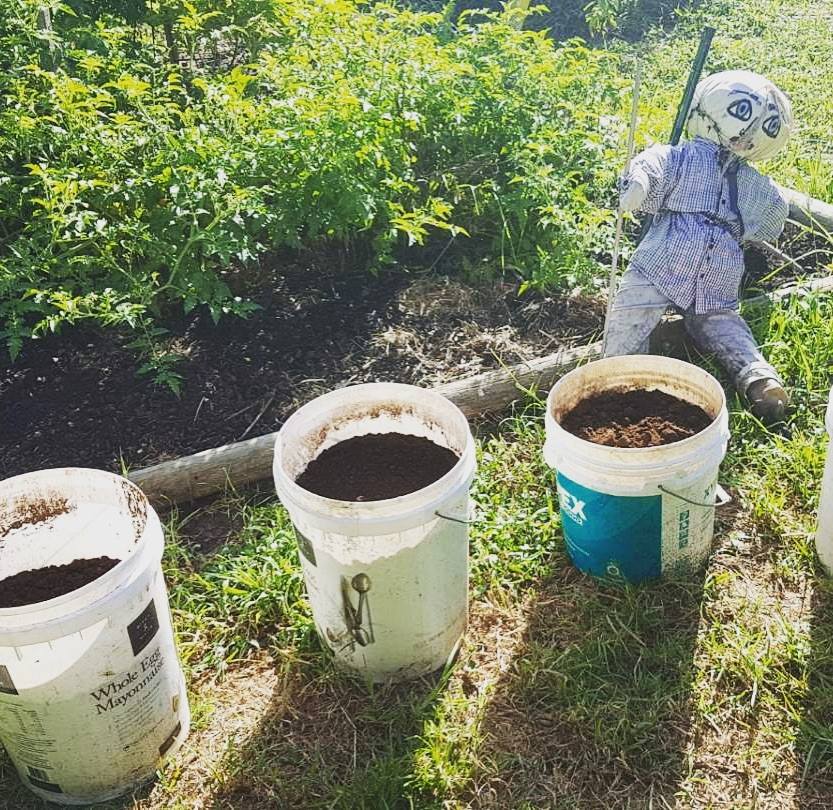
photo by Cafe Relish, North Avalon Shops
Avalon Community Garden undertakes to:
- Work collaboratively with the community, government, and business to establish a network of people and organisations that will facilitate the establishment and on-going support of community gardens.
- Reduce, reuse and recycle to influence the wider community in these practices.
- Adhere to the ethics of caring for land, people and resources.
- Provide information for the harmonious use of the Community Garden site by its members.
The value of community gardens
Recent years have seen an increasing trend towards the establishment of community gardens globally and in Australia there are many very successful community gardens. Long established community gardens show us that community gardens can do a lot more than simply provide fresh produce. They provide benefits for individuals and for the community as a whole.
Community gardens provide education on gardening, recycling and sustainable use of natural resources. They develop community connections and a means of engaging youth, children, the elderly, the disabled and otherwise marginalised individuals in mutually enjoyable and rewarding activities, thus helping to develop more functional and resilient communities.
People involved in community gardens say they improve wellbeing by increasing physical activity and reducing stress, providing opportunities to interact meaningfully with new friends, give time for relaxation and reflection as well as an opportunity to improve their interconnectedness with nature.
Organics and permaculture
Incorporating permaculture principles in the design and operation of the garden shows it is possible to create systems that are ecologically sound and economically viable while being firmly based on organic principles. The design and operation aims to minimise work and enhance productivity by, among other things:
- Making the most out of the natural characteristics of landscapes and structures;
- Using the inherent qualities and natural relationships between plants and animals;
- Ensuring healthy soil development through composting and/or worm farming;
- Planning for gardens and structures to effectively harvest and manage water, and
- Caring for and respecting the needs of people.
Deadly Frog Fungus Has Wiped Out 90 Species And Threatens Hundreds More
March 29, 2019
It started off as an enigma. Biologists at field sites around the world reported that frogs had simply disappeared. Costa Rica, 1987: the golden toad, missing. Australia, 1979: the gastric brooding frog, gone. In Ecuador, Arthur’s stubfoot toad was last seen in 1988.
By 1990, cases of unexplained frog declines were piling up. These were not isolated incidents; it was a global pattern – one that we now know was due to chytridiomycosis, a fungal disease that was infecting and killing a huge range of frogs, toads and salamanders.
Our research, published today in Science, reveals the global number of amphibian species affected. At least 501 species have declined due to chytrid, and 90 of them are confirmed or believed extinct.

The Mossy Red-eyed Frog is among hundreds of species threatened with extinction at the hands of chytrid fungus. Jonathan Kolby/Honduras Amphibian Rescue and Conservation Center
When biologists first began to investigate the mysterious species disappearances, they were at a loss to explain them. In many cases, species declined rapidly in seemingly pristine habitat.
Species declines typically have obvious causes, such as habitat loss or introduced species like rats. But this was different.
The first big breakthrough came in 1998, when a team of Australian and international scientists led by Lee Berger discovered amphibian chytrid fungus. Their research showed that this unusual fungal pathogen was the cause of frog declines in the rainforests of Australia and Central America.
However, there were still many unknowns. Where did this pathogen come from? How does it kill frogs? And why were so many different species affected?
After years of painstaking research, biologists have filled in many pieces of the puzzle. In 2009, researchers discovered how chytrid fungus kills frogs. In 2018, the Korean peninsula was pinpointed as the likely origin of the most deadly lineage of chytrid fungus, and human dispersal of amphibians suggested as a likely source of the global spread of the pathogen.
Yet as the mystery was slowly but surely unravelled, a key question remained: how many amphibian species have been affected by chytrid fungus?
Early estimates suggested that about 200 species were affected. Our new study reveals the total is unfortunately much larger: 501 species have declined, and 90 confirmed or suspected to have been killed off altogether.
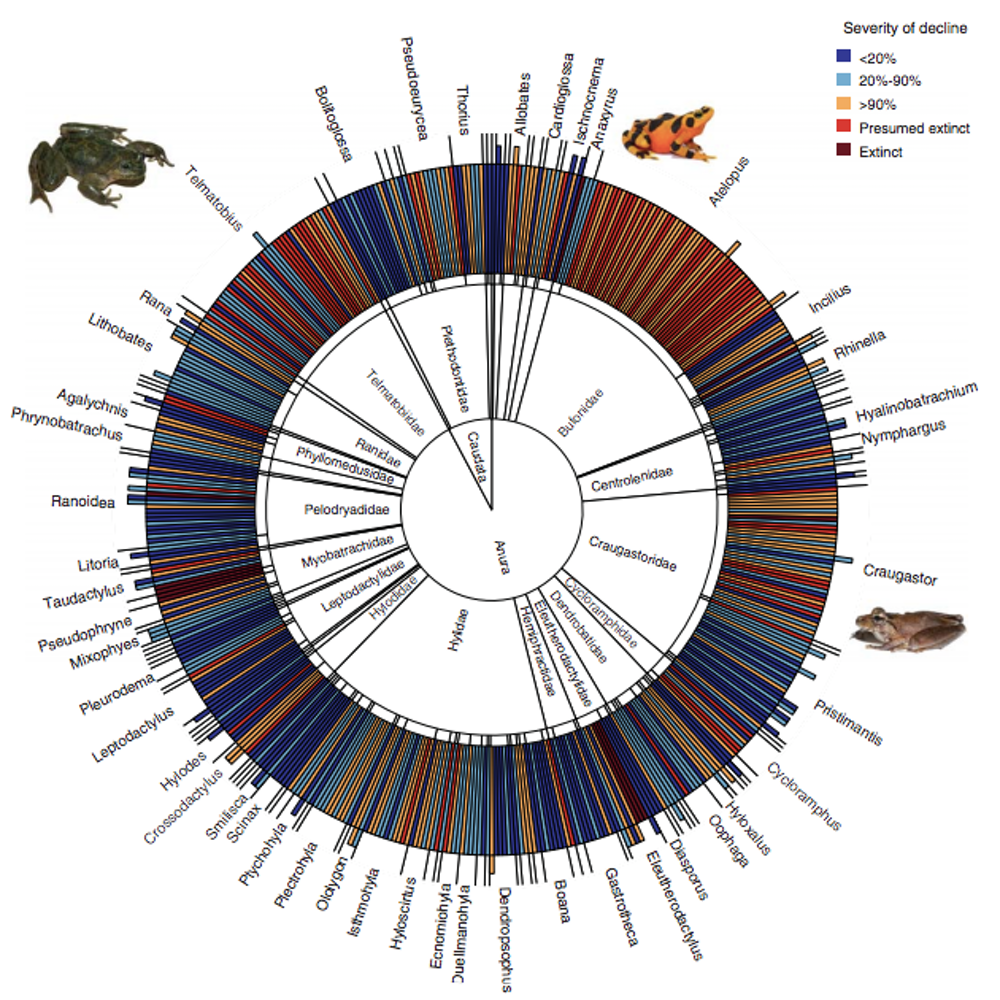
The toll taken by chytrid fungus on amphibians around the world. Each bar represents one species; colours reveal the extent of population declines. Scheele et al. Science 2019
Devastating killer
These numbers put chytrid fungus in the worst league of invasive species worldwide, threatening similar numbers of species as rats and cats. The worst-hit areas have been in Australia and Central and South America, which have many different frog species, as well as ideal conditions for the growth of chytrid fungus.
Large species and those with small distributions and elevational ranges have been the mostly likely to experience severe declines or extinctions.
Together with 41 amphibian experts from around the world, we pieced together information on the timing of species declines using published records, survey data, and museum collections. We found that declines peaked globally in the 1980s, about 15 years before the disease was even discovered. This peak coincides with biologists’ anecdotal reports of unusual amphibian declines that occurred with increasing frequency in the late 1980s.
Encouragingly, some species have shown signs of natural recovery. Twelve per cent of the 501 species have begun to recover in some locations. But for the vast majority of species, population numbers are still far below what they once were.
Most of the afflicted species have not yet begun to bounce back, and many continue to decline. Rapid and substantial action from governments and conservation organisations is needed if we are to keep these species off the extinct list.
In Australia, chytrid fungus has caused the decline of 43 frog species. Of these, seven are now extinct and six are at high risk of extinction due to severe and ongoing declines. The conservation of these species is dependent on targeted management, such as the recovery program for the iconic corroboree frogs.
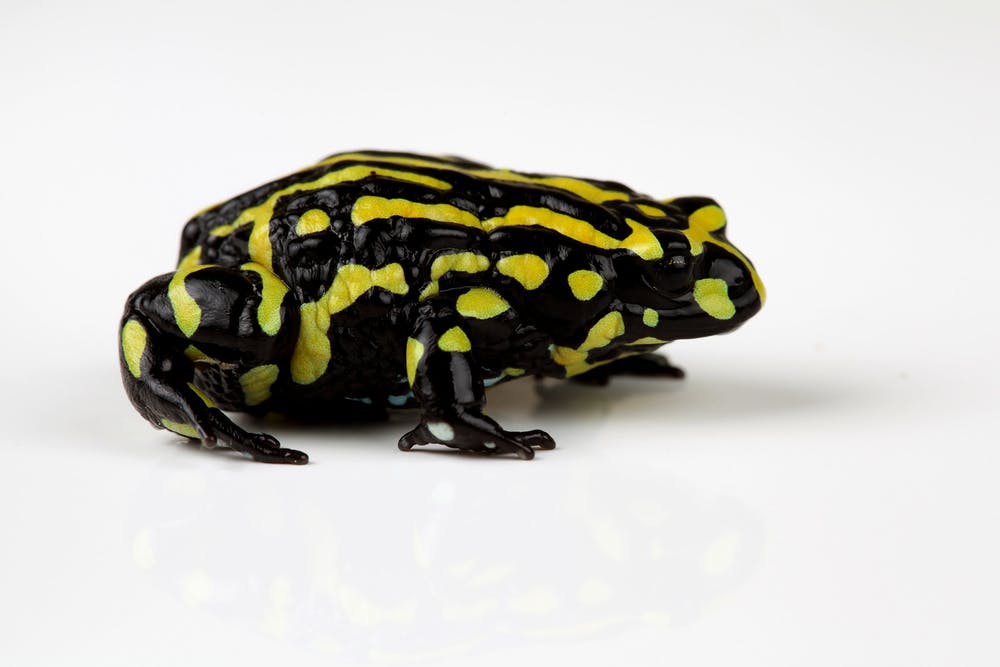
The southern corroboree frog: hopefully not a disappearing icon. Photo by Corey Doughty
Importantly, there are still some areas of the world that chytrid has not yet reached, such as New Guinea. Stopping chytrid fungus spreading to these areas will require a dramatic reduction in the global trade of amphibians, as well as increased biosecurity measures.
The unprecedented deadliness of a single disease affecting an entire class of animals highlights the need for governments and international organisations to take the threat of wildlife disease seriously. Losing more amazing species like the golden toad and gastric brooding frog is a tragedy that we can avoid.
This article was published first in The Conversation and can be read, including all links, here - republished via Creative Commons licence.
Authors
Benjamin Scheele; Research Fellow in Ecology, Australian National University
Claire Foster; Research Fellow in Ecology and Conservation, Australian National University
Are More Aussie Trees Dying Of Drought? Scientists Need Your Help Spotting Dead Trees
March 27, 2019
The following opinion piece, co-authored by Professor Belinda Medlyn and Associate Professor Brendan Choat from the Hawkesbury Institute for the Environment, was first published with full links on The Conversation.
Most citizen science initiatives ask people to record living things, like frogs, wombats, or feral animals. But dead things can also be hugely informative for science. We have just launched a new citizen science project, The Dead Tree Detective, which aims to record where and when trees have died in Australia.
The current drought across southeastern Australia has been so severe that native trees have begun to perish, and we need people to send in photographs tracking what has died. These records will be valuable for scientists trying to understand and predict how native forests and woodlands are vulnerable to climate extremes.
Understanding where trees are most at risk is becoming urgent because it’s increasingly clear that climate change is already underway. On average, temperatures across Australia have risen more than 1℃ since 1910, and winter rainfall in southern Australia has declined. Further increases in temperature, and increasing time spent in drought, are forecast.
How our native plants cope with these changes will affect (among other things) biodiversity, water supplies, fire risk, and carbon storage. Unfortunately, how climate change is likely to affect Australian vegetation is a complex problem, and one we don’t yet have a good handle on.
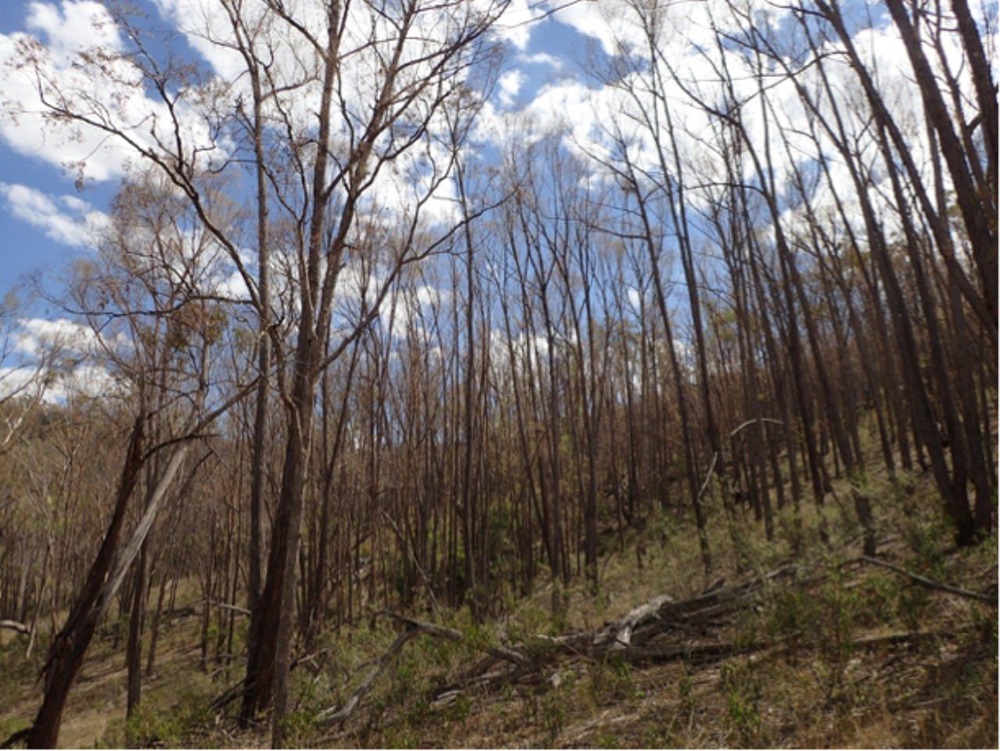
Phil Spark of Woolomin, NSW submitted this photo to The Dead Tree Detective project online. Author provided
Climate niche
All plants have a preferred average climate where they grow best (their “climatic niche”). Many Australian tree species have small climatic niches.
It’s been estimated an increase of 2℃ would see 40% of eucalypt species stranded in climate conditions to which they are not adapted.
But what happens if species move out of their climatic niche? It’s possible there will be a gradual migration across the landscape as plants move to keep up with the climate.
It’s also possible that plants will generally grow better, if carbon dioxide rises and frosts become less common (although this is a complicated and disputed claim.
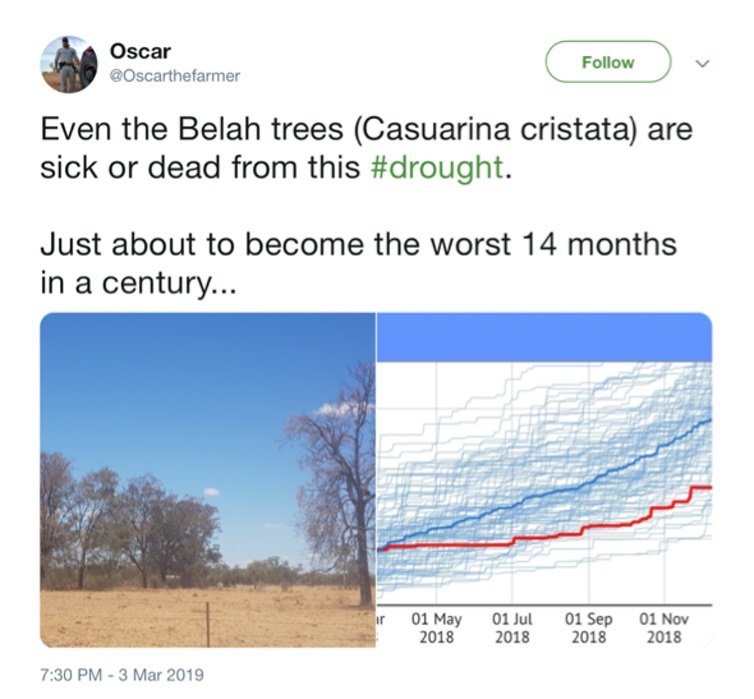
Farmers have reported anecdotal evidence of tree deaths on social media. Author provided
However, a third possibility is that increasing climate extremes will lead to mass tree deaths, with severe consequences.
There are examples of all three possibilities in the scientific literature, but reports of widespread tree death are becoming increasingly commonplace.
Many scientists, including ourselves, are now trying to identify the circumstances under which we may see trees die from climate stress. Quantifying these thresholds is going to be key for working out where vegetation may be headed.
The water transport system
Australian plants must deal with the most variable rainfall in the world. Only trees adapted to prolonged drought can survive. However, drought severity is forecast to increase, and rising heat extremes will exacerbate drought stress past their tolerance.
To explain why droughts overwhelm trees, we need to look at the water transport system that keeps them alive. Essentially, trees draw water from the soil through their roots and up to their leaves. Plants do not have a pump (like our hearts) to move water – instead, water is pulled up under tension using energy from sunlight. Our research illustrates how this transport system breaks down during droughts.
In hot weather, more moisture evaporates from trees’ leaves, putting more pressure on their water transport system. This evaporation can actually be useful, because it keeps the trees’ leaves cool during heatwaves. However if there is not enough water available, leaf temperatures can become lethally high, scorching the tree canopy.
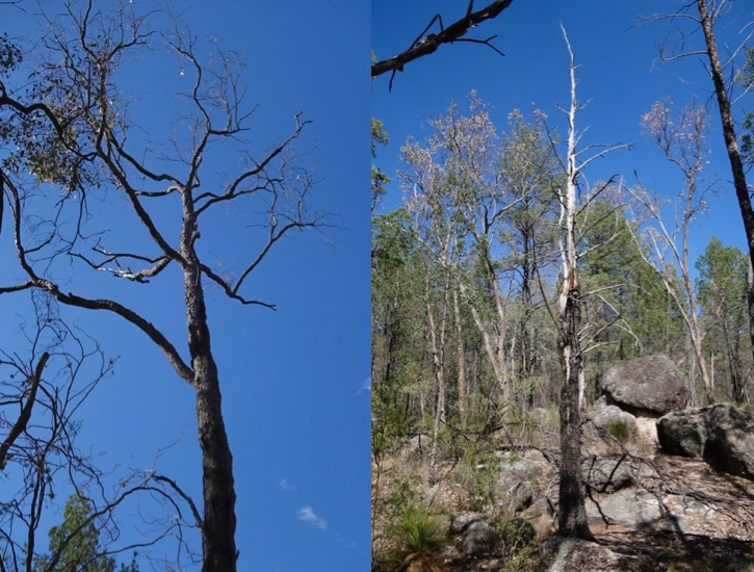
Lyn Lacey submitted these photos of dead trees at Ashford, NSW to The Dead Tree Detective. Author provided
We’ve also identified how drought tolerance varies among native tree species. Species growing in low-rainfall areas are better equipped to handle drought, showing they are finely tuned to their climate niche and suggesting many species will be vulnerable if climate change increases drought severity.
Based on all of these data, we hope to be able to predict where and when trees will be vulnerable to death from drought and heat stress. The problem lies in testing our predictions – and that’s where citizen science comes in. Satellite remote sensing can help us track overall greenness of ecosystems, but it can’t detect individual tree death. Observation on the ground is needed.
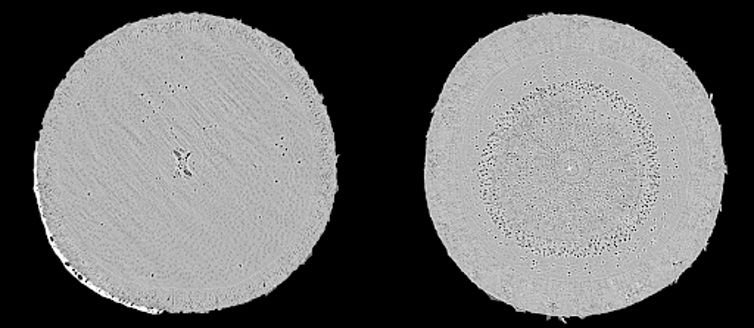
These images show a failure of the water transport system in Eucalyptus saligna. Left: well-watered plant. Right: severely droughted plant. On the right, air bubbles blocking the transport system can be seen. Brendan Choat, Author provided
However, there is no system in place to record tree death from drought in Australia. For example, during the Millennium Drought, the most severe and extended drought for a century in southern Australia, there are almost no records of native tree death (other than along the rivers, where over-extraction of water was also an issue). Were there no deaths? Or were they simply not recorded?
The current drought gripping the southeast has not been as long as the Millennium Drought, but it does appear to be more intense, with some places receiving almost no rain for two years. We’ve also had a summer of repeated heatwaves, which will have intensified the stress.
We’re hearing anecdotal reports of tree death in the news and on twitter. We’re aiming to capture these anecdotal reports, and back them up with information including photographs, locations, numbers and species of trees affected, on the Dead Tree Detective.
We encourage anyone who sees dead trees around them to hop online and contribute. The Detective also allows people to record tree deaths from other causes – and trees that have come back to life again (sometimes dead isn’t dead). It can be depressing to see trees die – but recording their deaths for science helps to ensure they won’t have died in vain.
Mercury Australia Network Launched At ANU
March 28, 2019
The Mercury Australia (MA) network has been launched at ANU with the goal of assisting Australia to ratify the United Nations Minamata Convention on Mercury.
The new network unites the efforts of Australia's 20 university researchers studying the presence, use and impacts of mercury in Australia, and seeks to engage with government, industry and the public.
Co-convenors of MA are Dr Larissa Schneider of ANU and Dr Darren Sinclair from the University of Canberra. They say there is not enough high quality, independent research into this dangerous heavy metal in Australia.
"Research into mercury in Australia is scarce compared to other countries and there is a lack of information on the cycle of mercury," said Dr Schneider.
Eight Australian universities will contribute research to MA, which aims to determine priority areas for research in Australia as well as better coordinate, consolidate and communicate studies into the use, presence and impacts of mercury in the Australian environment.
Dr Schneider said 128 countries including China, America and the European Union have ratified the UN Convention, which came into force in 2017.
Although Australia has signed the Convention, it is yet to ratify it.
"The launch of the Mercury Australia Network is timely as it will be able to provide data and information needed to meet our obligations under the Convention.
"The work of Mercury Australia will provide quality, independent research that will be available to the public and which we hope will translate into regulation, governance and policy advice for governments," said Dr Schneider.
First Assistant Secretary to the Department of Environment and Energy, James Tregurtha attended the launch.
"I welcome the formation of Mercury Australia, and look forward to continued contributions from the Australian mercury research community," he said.
Information, research and findings of Mercury Australia are available on the network's website: www.mercury-australia.com.au
Duckweed: The Low-Down On A Tiny Plant
March 26, 2019: University of Münster
Duckweeds -- for many aquatic animals like ducks and snails, a treat, but for pond owners, sometimes a thorn in the side. The tiny and fast-growing plants are of great interest to researchers, and not at least because of their industrial applications -- for example, to purify wastewater or generate energy.
An international research team from Münster, Jena (both Germany), Zurich (Switzerland) and Kerala (India) has recently studied the genomics of the giant duckweed. They discovered that genetic diversity, i.e. the total number of genetic characteristics that are different among individuals, is very low.
"This is remarkable given that their population size is very large -- there can, for example, be millions of individuals in a single pond," says Shuqing Xu, professor for plant evolutionary ecology at the University of Münster and lead author of the study.
To understand the reason behind this mystery, a team of plant researchers headed by Dr. Meret Huber from the Max Planck Institute for Chemical Ecology in Jena and the University of Münster measured the mutation rate of this duckweed under outdoor conditions, i.e. how many mutations accumulate per generation. The result: low genetic diversity in this plant was accompanied by an extremely low mutation rate. "Our study emphasizes that accurate estimates of mutation rates are important for explaining patterns of genetic diversity among species," says Meret Huber. The results are not only relevant for future studies on the evolution of plants, including many crops that have similar reproductive strategies like duckweeds, they will also accelerate the use of duckweeds both for basic research and industrial applications. The study was published in the journal Nature Communications.
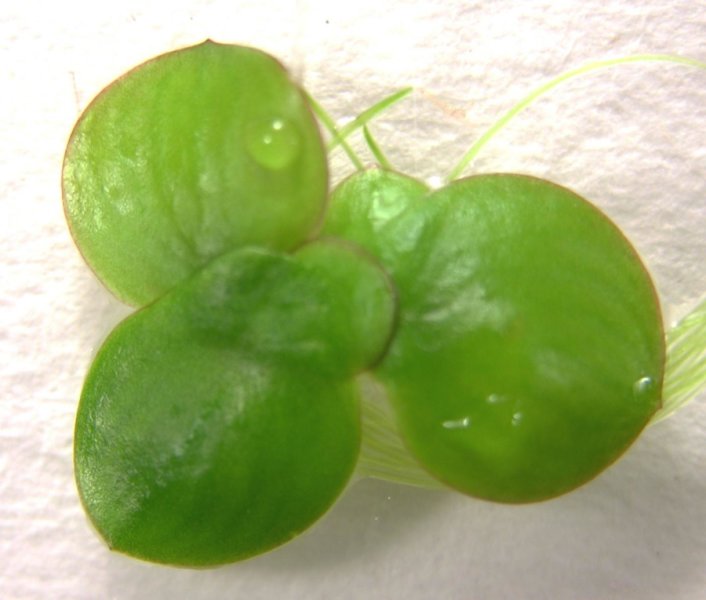
A close-up of the giant duckweed.
Credit: © Klaus J. Appenroth
Background
Although mutations are the raw materials for evolutionary changes, they are often accompanied by fitness impairments. Evolutionary researchers have hypothesized that natural selection in species with large populations drives the mutation rate to as low as possible. According to this hypothesis, a species with a very large population size may under certain conditions evolve an extremely low mutation rate -- which in turn can result in a very low genetic diversity. Until now, however, scientists had not been able to show this connection in eukaryotes, i.e. organisms whose cells have a nucleus. One reason for this is that mutation rates are difficult to measure experimentally.
The researchers took samples of the giant duckweed (Spirodela polyrhiza) from 68 waterbodies distributed all over the world and read the DNA sequences of their entire genomes. They found that in congruence with their geographic origin the samples fall into four genetic clusters: America, Europe, India and Southeast Asia. Based on the genome sequence information, they found that the genetic diversity of the species is among the lowest values reported in multicellular eukaryotes.
Because genetic diversity is determined by mutation rate and effective population size, the scientists then experimentally estimated the mutation rates and calculated effective population size. Since external conditions can influence the mutation rate, they performed the experiments under outdoor conditions. The result: by sequencing genomes, they found that the mutation rate in the giant duckweed was the lowest ever determined for multicellular eukaryotes. The estimated effective population size, as expected, is rather large.
The researchers suspect that the enormous population size of the giant duckweed, and therefore the large possibilities of selection in the course of evolution, has led to the reduction of mutations to a minimum. This in turn can explain the low genetic diversity. "Our study provides new insights into why and how genetic diversity differs among different species," says Shuqing Xu.
Together with their collaborators, the scientists are currently working on analyzing genomes of even more duckweed samples and plan to carry out outdoor selection experiments. They wish to discover which other factors might have played roles in shaping the evolution of this plant.
Shuqing Xu, Jessica Stapley, Saskia Gablenz, Justin Boyer, Klaus J. Appenroth, K. Sowjanya Sree, Jonathan Gershenzon, Alex Widmer, Meret Huber. Low genetic variation is associated with low mutation rate in the giant duckweed. Nature Communications, 2019; 10 (1) DOI: 10.1038/s41467-019-09235-5
PITTWATER YHA OFFERS FREE BEDS FOR GREEN HEARTS
This May, Pittwater YHA opens its doors to green-hearted and green-thumbed guests who'll save the gorgeous Ku-ring-gai Chase National Park from imminent asparagus fern invasion. Yes, seriously.
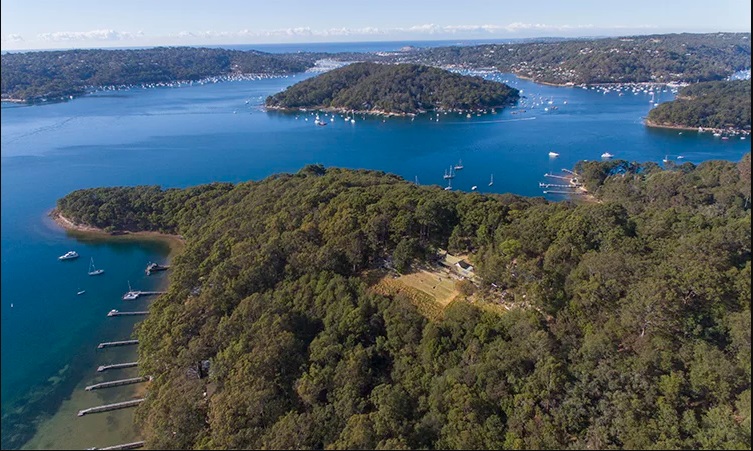
WHAT IS IT?
Bush Regeneration sees eco-conscious, kind hearted humans restore and rehabilitate the gorgeous, sprawling Aussie bush from its weed-infested, degraded state into a healthy, thriving plant community, which will prosper and delight forevermore. Far from just weed removal; Regenerators focus on habitat, drainage, weed sources and establishing native communities. These are big words which probably don’t make much sense – but we have an interactive learning opportunity for you!
WHERE IS IT?
Ku-ring-gai Chase National Park, Sydney’s protected north coast, is home to rock engravings, red ochre rock paintings, the fuzziest wildlife you ever did see and the most breathtaking views a Sydneysider or visitor could comprehend; and is currently under threat from invasive asparagus fern; which needs removing. Who knew your Aunty’s fave veggie could be so aggressive?
ALRIGHT - SIGN ME UP!
The blissed-out, babbling-brooked, spectacular-viewed, fresh-aired oasis that is our Pittwater YHA, alongside the Northern Beaches Council, are offering you fine green-thumbed and hearted folk the opportunity to volunteer alongside professional Regenerators for a weekend of Pittwater Restoration from May 3 - 5, 2019. Spend two mornings of tending to the gorgeous surrounds and you’ll be rewarded with two nights’ accommodation, two days of meals (morning teas, BBQ lunches and evening dinners) and kayak use throughout your stay. Plus, you’ll be chuffed with yourself for doing your bit for the planet and our futures.
Along with your towels, two sheets, a pillowcase and, sturdy shoes, sunscreen and your breakfasts; you’ll need a $20 contribution for the weekend. For all the T&Cs; head to Pittwater YHA, shoot them an email (Subject: 'Bush Regeneration Weekend') or give them a ring on (02 9999-5748) – the only thing those guys love more than a regenerated bushland is chatting to ladies and gentleman who are keen on the idea!
Archie's Pittwater Clean Up
My name is Archie Mandin
I am a Seabin Ambassador, I started this campaign because I want to take a stand against ocean plastics!
My goal is to raise enough money to bring a minimum of 20 Seabins to Pittwater NSW as I want to give The Northern Beaches the opportunity to reduce its plastic pollution impact on the ocean. Its amazing how much accidental rubbish comes down our creeks and into our waterways
I need your help to raise money to buy the Seabins a revolutionary ocean cleaning technology which is essentially a floating rubbish bin that operates 24/7 catching all floating debris in the water.
The Seabin helps clean the ocean of floating debris which in turn creates cleaner oceans and we all benefit from this in one way or another. I mean, who really wants to swim in pollution? Not me that’s for sure!
Did you know that 300 million tons of plastic are produced in the world every year, half of which is for single use products, from this more than 8 million tons of plastic is dumped into our oceans every year. We need to do something about it and now with the purchase of a Seabin we can all participate and make a difference!
Join me and my campaign to help ensure cleaner oceans!
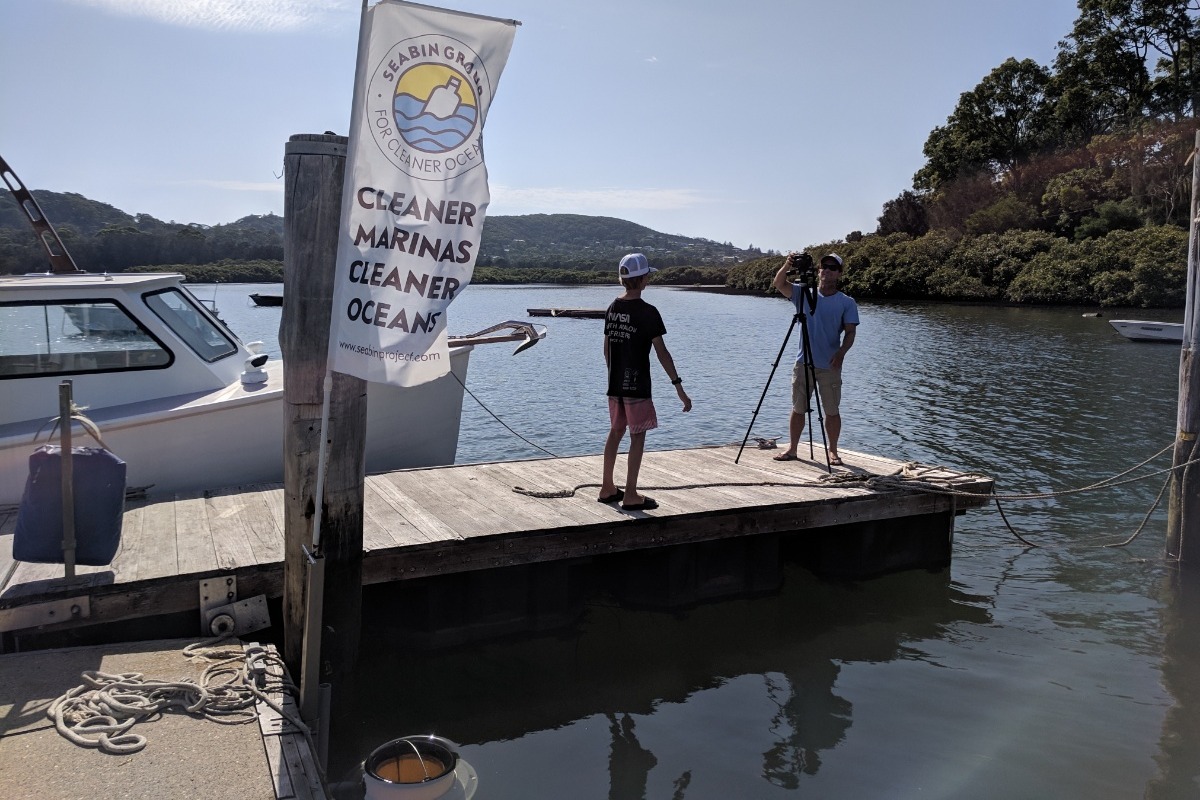
What’s a Seabin?
The Seabin is a floating rubbish bin that is located in the water at marinas, docks, yacht clubs and commercial ports.
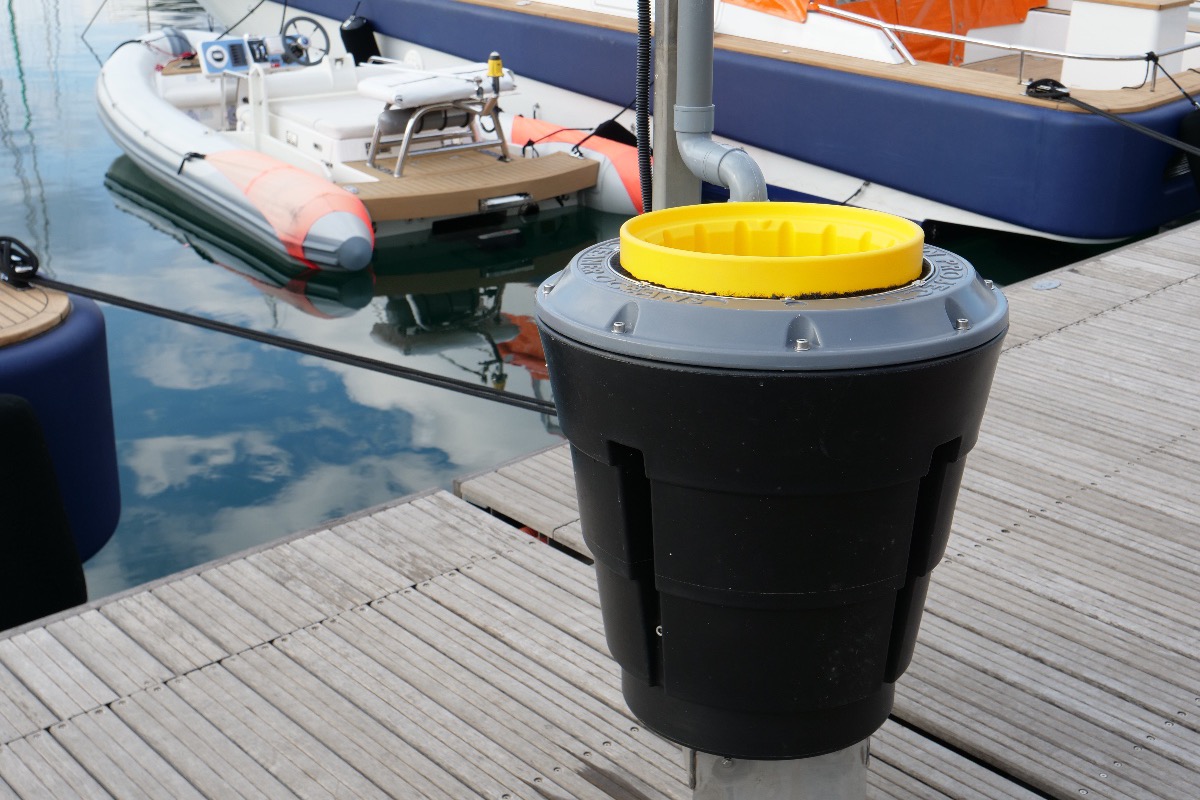
The Seabin can catch an average of 3.9kgs of floating debris per day which adds up to 1.4 tons per year. (depending on weather conditions and debris volumes) The Seabins is catching large plastic bags, bottles, plastic straws, coffee cups, food wrappers, surface oils and micro plastics down to 2 mm small.
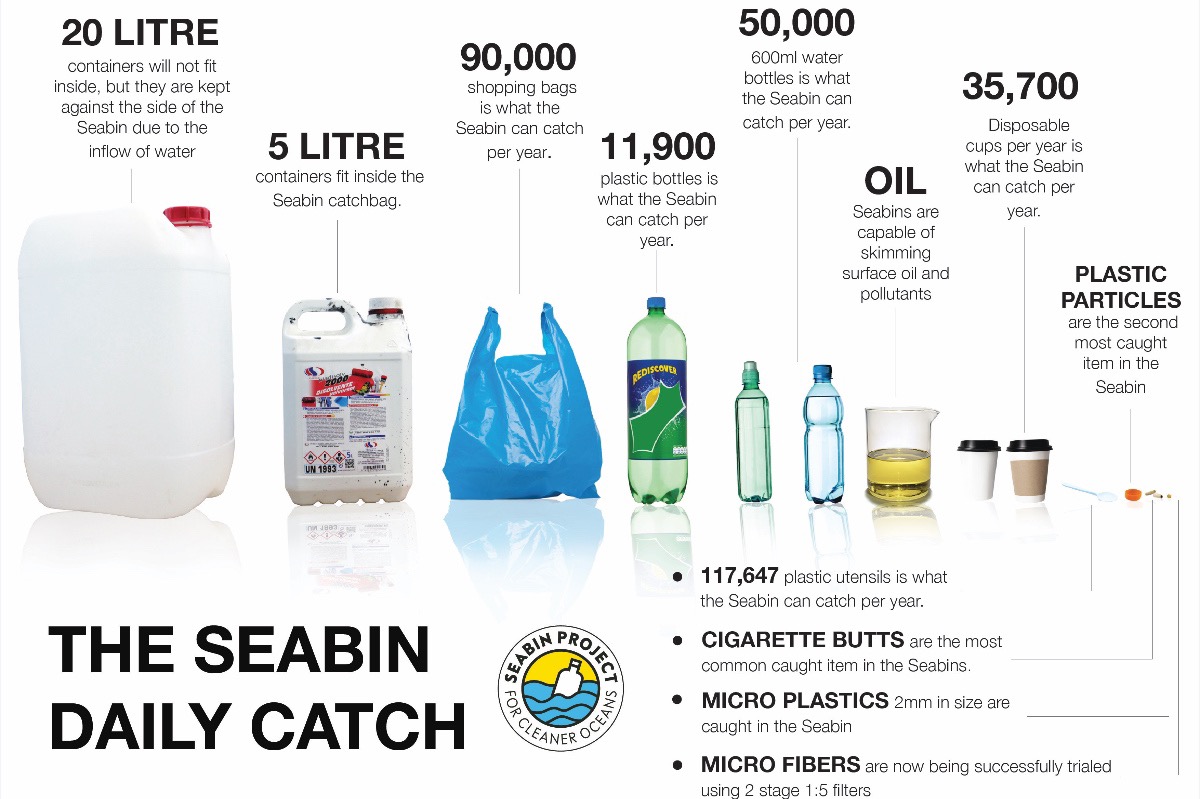
How can a Seabin contribute to cleaner oceans?
The Seabin contributes to cleaner oceans by removing 1.4 tons of floating debris per unit per year. The location of the Seabin in marinas is ideal and where it matters most, close to the source of entry for floating debris. Ports and Marinas are perfect locations to stop floating debris from entering the open ocean and ocean plastics are also brought in by wind and currents.
Are the Seabins a danger to marine life?
The fish According to the team at Seabin, stay away from the surface of the water where the Seabin sucks in the water. They are deterred by the force of the water current. If there are swarms of jellyfish or bait fish it is recommended that the Seabins are turned off until the swarms pass. If a fish was to accidentally go into the Seabin, it would be caught in the Seabin and stay submerged in water until the marina staff retrieve the filter and throw the fish still alive back into the water.
How does it work?
Water is sucked in from the surface and passes through a catch bag inside the Seabin, with a submersible water pump capable of displacing 25.000 LPH (liters per hour). The water is then pumped back into the marina leaving litter and debris trapped in the catch bag to be disposed of properly.
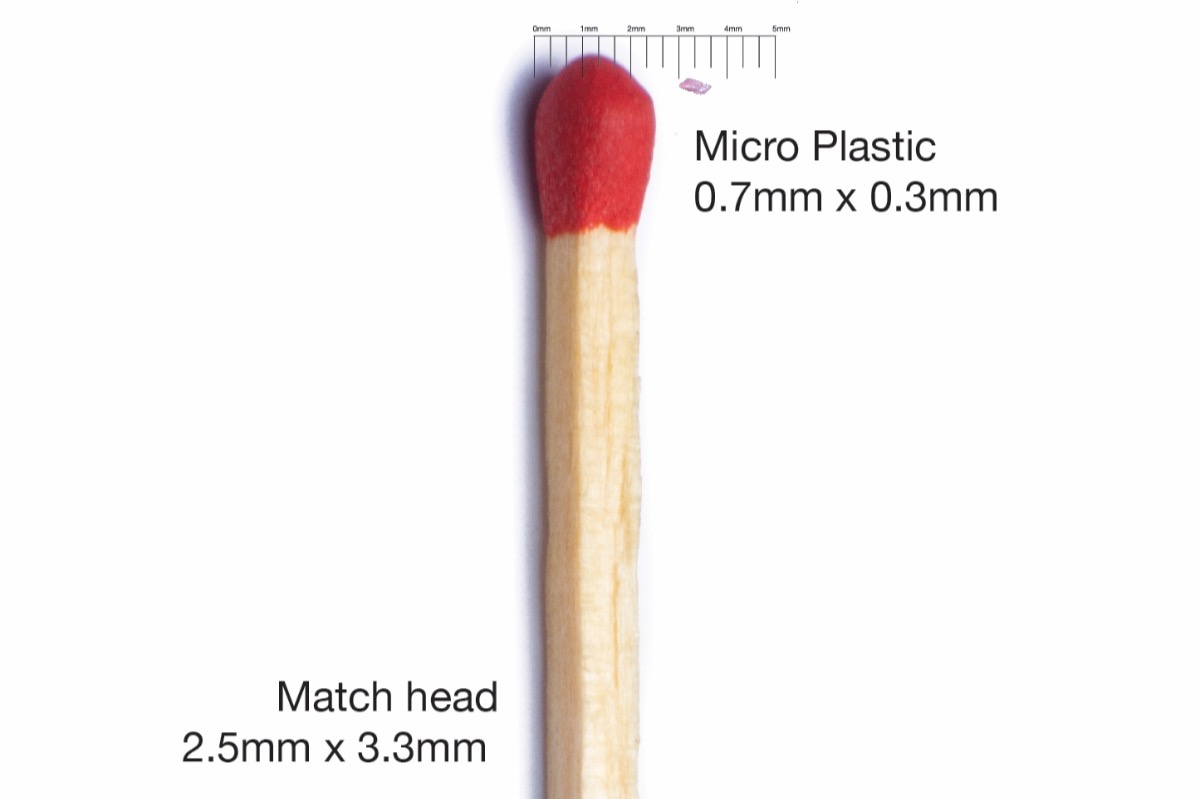
Who is responsible for the Seabin?
This is the best part of it all, the marina will be the one responsible for the upkeep of the Seabins and also they will be paying for the energy consumption of the Seabin which is around $2 - $3 a day.
The marina enjoys a cleaner marina and the rest of us and the marine life enjoy cleaner oceans with less floating debris polluting our oceans!
Seabins part of a whole solution
Seabins whole solution is Technology, Education, Science, Research and Community. The reason for this is that Technology alone is not the solution to stopping ocean plastics, education is the real solution.

Great! Can our local community be involved also?
Yes! The team at Seabin have interactive programs and lessons designed for schools, community and youth to interact with the Seabins and have over 2000 school students engaged around the world, this is something that we can do locally also with support from the team at Seabin Project.
What will we be doing if we participate in these programs?
You would be joining an international community contributing important data and feedback on ocean plastics to the Seabin central data base. Renowned scientists, universities and environmental agencies are all a part of the programs also.
The lessons range from identifying ocean plastics to data collection of what the Seabins are catching weekly. The data collection is a very easy activity and where we can all see the measurable impact of debris the Seabins are taking out of the water in all weather conditions.
It’s as simple as counting how many plastic bags, plastic particles, food wrappers and then noting it down on a spreadsheet or app. Weather conditions and location information is also entered into the data base.
How can you help our campaign and make a difference in the world?
Every contribution to this crowdfunding campaign helps, be it $1 or $50 dollars, it all adds up and bring us closer to our goal.
Even if you cannot afford a donation, please help by sharing this campaign with your friends and family on social media. The more people that know about the campaign the better!
Thanks everyone for taking the time to check out our campaign!
FOR CLEANER OCEANS!
Archie
FAQS SHEET
Seabin Project FAQs
Q: Can someone pay out the crowdfunding campaign goal?
A: Yes! We need help! The more money we can raise, the more Seabins we can buy.
Q: Why crowdfund a Seabin?
A: Until now, the Seabins were not for the everyday person to purchase because marinas ports and yacht clubs are the target market for Seabin Group. This is a way where everyday people can give something back to the oceans.
Q: How do Seabins work in tidal areas?
A: Seabins at present are designed for floating docks and pontoons. The Seabins move up and down with the tide on the floating dock.
Q. How are the pumps run?
A. The pumps are currently electric, and around $2-$3 a day to run.
Q: When are the Seabins available?
A: Depending on your countries location, Seabins will be available Feb 2019.
Q: Do any fish get sucked into the Seabins? What about smaller marine life?
A: There is a possibility of fish to enter the Seabins, however in the last 2 years of development, the Seabins have only caught a handful of small bait fish. Most of which have been thrown back into the water alive. The fish simply stay away from the flow of water entering the Seabin and with the current fine tuning of the Seabin, the risk is now minimal.
Q: I don’t have any money to donate, how can I help?
A: Don’t worry! Your amazing anyways and thanks for even contacting us. We need help to share this project around with any media we can. Social media platforms like Facebook, Instagram, Twitter, websites, bloggers. Also with newspapers, magazines, tv, radio and journalists. Also friends and family!
After Opal Tower: UNSW Researchers To Investigate Major Building Defects
March 28, 2019: Ben Knight, UNSW Media
The City Futures Research Centre’s new ARC Linkage Project will put the multi-unit housing sector under the microscope and propose specific changes to protect people buying units.
UNSW Sydney’s City Futures Research Centre will address the severe and growing concern about building quality issues in the multi-unit housing sector.
The centre has been awarded a $273,702 ARC Linkage Grant for a two-year project to tackle major defects in strata housing in NSW.
The project, led by UNSW City Futures Director Professor Bill Randolph, will build on previous research to accurately identify the scale of major defects threatening to undermine the multi-unit housing sector. The project team also includes UNSW Built Environment Professor Martin Looseman, UNSW Scientia Fellow Dr Hazel Easthope and UNSW City Futures Research Fellow Dr Laura Crommelin.
As well as identifying the prevalence of significant building defects, the project will seek to understand the causes and provide innovative solutions to improve housing quality, which could bring about sweeping changes to the sector.
The multi-unit housing sector in Australia is estimated to be worth more than $1 trillion and provides almost half of new Australian housing. Sydney is at the forefront of the construction revolution, now building more units than standalone houses.
A previous study conducted by the City Futures Research Centre, one of the only quantitative assessments of multi-unit housing defects in Australia to date, found that 75-85% of owners’ corporations had identified at least one significant defect in their building.
“It is generally recognised that developments in residential buildings have a high proportion of defects when they’re built,” says Professor Randolph.
“Despite these problems, there is no comprehensive data available on defective apartment buildings … what kinds of defects exist, or why they’ve occurred.
“We have now put together a team of industry partners to support a new research project to address this knowledge gap.”
The research will focus on three areas of Sydney’s biggest high-density housing markets – City of Sydney, Paramatta and Canterbury-Bankstown.
Professor Randolph says the project methodology is one of the most ambitious undertaken by the research centre and will engage stakeholders across industries, including strata, insurance and law.
“We're actually going to do an in-depth data gathering exercise on about 600 of these blocks in these three areas, with a view to trying to work out what's going on – which ones have defects, what are the defects if they have them and, importantly, how much it is going to cost to fix and by whom.
“It hasn’t been done before – nobody's ever done it before because it's a tough job.”
Professor Randolph anticipates the project will also have international implications in markets such as the US and the UK.
“It’s certainly of a comparable scale internationally.
“There are lots of high-density towers going up in cities like London and Toronto, let alone Singapore and Hong Kong, and with very similar processes and conditions in the investor market which is driving the development.
“It’s happening everywhere, and it's a generic issue worldwide.”
He believes the project will further uncover fundamental issues the housing sector – being undermined by cascading risks, blame shifting and lack of oversight.
“There's a whole series of places where things can go wrong.
“There’s a whole chain of risk which is pushed further and further down the chain from the developers right down to the sub-contractors, where people can cut corners, as they did in the Opal Tower, and nobody really checks up on them, because there is no proper oversight.
“They basically self-certify themselves, and that's a real problem,” Professor Randolph says.
“Quality control methods need to change, and our project will give some pointers as to how that might happen.”
The Professor says that the combination of continued high-density growth and the unknown scale of major structural defects is unsettling, and poses a real threat to the viability of future cities.
He says the project comes at a pivotal time, following growing concern about the safety and quality of new buildings after the infamous Opal Tower saga.
“This is not a minor problem, as the recent Opal Tower incident has made clear – the majority of new dwellings in Sydney are multi-unit.
“Cities by and large are growing rapidly and are being reformed with multi-units in a way and in a scale that has never been done before.
“Therefore, if we're building sub-par quality, then we've got a real problem on our hands now, and in the future.”
The issue of defects is of real concern to the strata industry, given the risks posed if sentiment turns against apartment living, according to Professor Randolph.
He says that dealing with defects is a critical matter for urban planners, that, if not addressed, will pose a significant threat to Australia’s real estate market.
“The worry is people won’t want to live in these apartments because they feel they’re problematic, and I think Opal Tower exposed this. Then the market will collapse … on a scale that we haven’t seen before.”
Professor Randolph hopes to see the balance of power shift towards the consumer, with increased transparency, extensive building documentation, and more information about track records and developing defects rectification guide.
“Thousands of consumers are buying properties and they really don't know whether they're good, bad or indifferent.
“We need to get this information and knowledge into the hands of the consumers which will help shift the balance into their hands rather than have it all on the side of the developers.
“The good developers will welcome it and welcome a more knowledgeable consumer. The bad ones will be squeezed out of the market.”
An interim report on the project findings will be released at the end of the year.
'Technoference': We're More Tired And Less Productive Because Of Our Phones
March 25, 2019: Queensland University of TechnologyStudy finds problematic phone use getting worse in AustraliaOne in five women and one in eight men are now losing sleep due to the time they spend on their mobile phones, according to new QUT-led research that has found a jump in 'technoference' over the past 13 years.
Researchers surveyed 709 mobile phone users across Australia aged 18 to 83 in 2018, using questions replicated from a similar survey back in 2005.
They then compared the findings and discovered significant increases in people blaming their phones for losing sleep, becoming less productive, taking more risks while driving and even getting more aches and pains.
Study leader Dr Oscar Oviedo-Trespalacios from QUT's Centre for Accident Research and Road Safety -- Queensland (CARRS-Q) said the survey results showed 24 per cent of women and 15 per cent of men could now be classified as "problematic mobile phone users."
For 18 to 24 year-olds, the figure jumps to 40.9 per cent, with 23.5 per cent of respondents aged 25 to 29 also suffering technoference.
Participants were also asked about their driving habits, with researchers finding a correlation between problem phone use off the road and on the road.
Key findings of the 2018 national survey include:
- One in five women (19.5 per cent) and one in eight men (11.8 per cent) now lose sleep due to the time they spend on their mobile phone (vs 2.3 per cent of women and 3.2 per cent of men in 2005).
- 12.6 per cent of men say their productivity has decreased as a direct result of the time they spend on their mobile -- compared to none in 2005 -- and 14 per cent of women have also noticed a productivity decline (2.3 per cent in 2005).- 14 per cent of women try to hide the amount of time they spend on the phone (3 per cent in 2005), as do 8.2 per cent of men (3.2 per cent in 2005)
- 54.9 per cent of women believe their friends will find it hard to get in touch with them if they don't have a mobile (up from 28.8 per cent), and 41.6 per cent of men thought this (almost identical to 41.9 in 2005).
- 8.4 per cent of women (up from 3 per cent) and 7.9 per cent of men (up from 1.6 per cent) have aches and pains they attribute to mobile phone use
- 25.9 per cent of women (up from 3.8) and 15.9 per cent of men (up from 6.5) say there are times when they would rather use their mobile phone than deal with more pressing issues. For 18 to 25 year-olds, this figure was 51.4 per cent (up from 10.5).
Dr Oviedo-Trespalacios said the survey had uncovered an interesting pattern of "technoference."
"When we talk about technoference we're referring to the everyday intrusions and interruptions that people experience due to mobile phones and their usage," he said.
"Our survey found technoference had increased among men and women, across all ages.
"For example, self-reports relating to loss of sleep and productivity showed that these negative outcomes had significantly increased during the last 13 years.
"This finding suggests that mobile phones are potentially increasingly affecting aspects of daytime functioning due to lack of sleep and increasing dereliction of responsibilities."
But on the positive side, less people reported they had received phone bills they could not afford to pay. And, perhaps surprisingly, the number of people who found it difficult to switch off their phone remained fairly constant across the 13-year time span.
Dr Oviedo-Trespalacios said the survey results also indicated that phones were being used as a coping strategy, with one in four women and one in six men saying they'd rather use their phone than deal with more pressing issues.
He said Australia had one of the highest smartphone penetration rates in the world, with about 88 per cent of adults now owning a smartphone. Globally, the world is expected to pass 2.5 billion smartphone users this year.
"The speed and depth of smartphone take-up in Australia makes our population particularly vulnerable to some of the negative consequences of high mobile phone use," he said.
"Rapid technological innovations over the past few years have led to dramatic changes in today's mobile phone technology -- which can improve the quality of life for phone users but also result in some negative outcomes.
"These include anxiety and, in some cases, engagement in unsafe behaviours with serious health and safety implications such as mobile phone distracted driving."
Oscar Oviedo-Trespalacios, Sonali Nandavar, James David Albert Newton, Daniel Demant, James G. Phillips. Problematic Use of Mobile Phones in Australia…Is It Getting Worse? Frontiers in Psychiatry, 2019; 10 DOI: 10.3389/fpsyt.2019.00105
March 25, 2019: Queensland University of Technology
Study finds problematic phone use getting worse in Australia
One in five women and one in eight men are now losing sleep due to the time they spend on their mobile phones, according to new QUT-led research that has found a jump in 'technoference' over the past 13 years.
Researchers surveyed 709 mobile phone users across Australia aged 18 to 83 in 2018, using questions replicated from a similar survey back in 2005.
They then compared the findings and discovered significant increases in people blaming their phones for losing sleep, becoming less productive, taking more risks while driving and even getting more aches and pains.
Study leader Dr Oscar Oviedo-Trespalacios from QUT's Centre for Accident Research and Road Safety -- Queensland (CARRS-Q) said the survey results showed 24 per cent of women and 15 per cent of men could now be classified as "problematic mobile phone users."
For 18 to 24 year-olds, the figure jumps to 40.9 per cent, with 23.5 per cent of respondents aged 25 to 29 also suffering technoference.
Participants were also asked about their driving habits, with researchers finding a correlation between problem phone use off the road and on the road.
Key findings of the 2018 national survey include:
- One in five women (19.5 per cent) and one in eight men (11.8 per cent) now lose sleep due to the time they spend on their mobile phone (vs 2.3 per cent of women and 3.2 per cent of men in 2005).- 12.6 per cent of men say their productivity has decreased as a direct result of the time they spend on their mobile -- compared to none in 2005 -- and 14 per cent of women have also noticed a productivity decline (2.3 per cent in 2005).- 14 per cent of women try to hide the amount of time they spend on the phone (3 per cent in 2005), as do 8.2 per cent of men (3.2 per cent in 2005)- 54.9 per cent of women believe their friends will find it hard to get in touch with them if they don't have a mobile (up from 28.8 per cent), and 41.6 per cent of men thought this (almost identical to 41.9 in 2005).- 8.4 per cent of women (up from 3 per cent) and 7.9 per cent of men (up from 1.6 per cent) have aches and pains they attribute to mobile phone use- 25.9 per cent of women (up from 3.8) and 15.9 per cent of men (up from 6.5) say there are times when they would rather use their mobile phone than deal with more pressing issues. For 18 to 25 year-olds, this figure was 51.4 per cent (up from 10.5).
Dr Oviedo-Trespalacios said the survey had uncovered an interesting pattern of "technoference."
"When we talk about technoference we're referring to the everyday intrusions and interruptions that people experience due to mobile phones and their usage," he said.
"Our survey found technoference had increased among men and women, across all ages.
"For example, self-reports relating to loss of sleep and productivity showed that these negative outcomes had significantly increased during the last 13 years.
"This finding suggests that mobile phones are potentially increasingly affecting aspects of daytime functioning due to lack of sleep and increasing dereliction of responsibilities."
But on the positive side, less people reported they had received phone bills they could not afford to pay. And, perhaps surprisingly, the number of people who found it difficult to switch off their phone remained fairly constant across the 13-year time span.
Dr Oviedo-Trespalacios said the survey results also indicated that phones were being used as a coping strategy, with one in four women and one in six men saying they'd rather use their phone than deal with more pressing issues.
He said Australia had one of the highest smartphone penetration rates in the world, with about 88 per cent of adults now owning a smartphone. Globally, the world is expected to pass 2.5 billion smartphone users this year.
"The speed and depth of smartphone take-up in Australia makes our population particularly vulnerable to some of the negative consequences of high mobile phone use," he said.
"Rapid technological innovations over the past few years have led to dramatic changes in today's mobile phone technology -- which can improve the quality of life for phone users but also result in some negative outcomes.
"These include anxiety and, in some cases, engagement in unsafe behaviours with serious health and safety implications such as mobile phone distracted driving."
Oscar Oviedo-Trespalacios, Sonali Nandavar, James David Albert Newton, Daniel Demant, James G. Phillips. Problematic Use of Mobile Phones in Australia…Is It Getting Worse? Frontiers in Psychiatry, 2019; 10 DOI: 10.3389/fpsyt.2019.00105

Tuck Into Colourful Fruits And Vegetables And See The Light
Antioxidants the key to lowering risk of age-related cataracts
March 25, 2019: University of South Australia
A $5.7 billion global medical bill to restore sight for the estimated 45 million people with cataracts could be slashed in half by a diet rich in colourful fruits and vegetables, according to an international study.
Researchers from China and the University of South Australia have published the first study of its kind to verify the link between foods high in antioxidants and a lower risk of age-related cataracts (ARC).
UniSA Senior Research Fellow Dr Ming Li and colleagues from Xi'an Jiaotong University analysed 20 studies from around the world looking at the impact of vitamins and carotenoids on cataract risk.
Despite some inconsistencies, the findings overwhelmingly support the benefits of eating citrus fruits, capsicum, carrots, tomatoes and dark green vegetables such as spinach, broccoli and kale to delay the onset of ARC.
Their paper has been published in the American Journal of Clinical Nutrition ahead of World Optometry Week (March 26-30).
"Age-related cataracts are the leading cause of visual impairment among the elderly throughout the world, with unoperated cataracts contributing to 35 per cent of all blindness," Dr Li says. "Although cataract extraction surgery is an effective method to restore vision, it will have cost society more than $5.7 billion by 2020."
With the population ageing dramatically and an increasing number of people needing surgery, urgent action is needed, the researchers say.
"If we could delay the onset of ARC by 10 years it could halve the number of people requiring surgery."
Improvements would rely on global changes to most of the world's diet, however, with current consumption of antioxidants well below the recommended level to prevent age-related cataracts.
Hong Jiang, Yue Yin, Chang-Rui Wu, Yan Liu, Fang Guo, Ming Li, Le Ma. Dietary vitamin and carotenoid intake and risk of age-related cataract. The American Journal of Clinical Nutrition, 2019; 109 (1): 43 DOI: 10.1093/ajcn/nqy270
New Muscular Disease: Myoglobinopathy
March 27, 2019: IDIBELL-Bellvitge Biomedical Research Institute
Researchers of the Bellvitge Biomedical Research Institute (IDIBELL) led by Dr. Montse Olivé have described in Nature Communications a new muscular disease caused by a mutation in the myoglobin gene. The study has been possible thanks to a collaboration with a group of geneticists from the University of Western Australia (UWA), led by Prof. Nigel Laing, and researchers from the Karolinska Institute (Stockholm, Sweden).
Myoglobin, the protein that gives muscles their red colour, has as its main function the transportation and intracellular storage of oxygen, acting as an oxygen reservoir when there are low levels (hypoxia) or a total lack thereof (anoxia). It also acts as scavenger of free radicals and other reactive oxygen species, avoiding cell damage due to oxidative stress.
"This is the first time that a disease caused by a mutation in the myoglobin gene has been identified," says Montse Olivé, doctor at the Bellvitge University Hospital, responsible for the muscular disease area and researcher of the Human Molecular Genetics group of the Genes, Disease and Therapy at IDIBELL. "We have identified the same mutation in several members of 6 unrelated European families, all of whom had the same symptoms and showed very characteristic lesions -- called sarcoplasmic bodies -- in muscle biopsies," adds Dr Olivé.
Myoglobinopathy, the name that has been proposed for the new disease, manifests between the fourth and fifth decade of life. It causes a progressive weakness of the axial and limb muscles, and in more advanced stages affects the respiratory musculature and the heart.
The study has also involved, among others, researchers from the ALBA synchrotron and the Autonomous University of Barcelona (UAB). The infrared microscopy of the MIRAS beamline at the synchrotron, which is able to characterize the chemical composition and structure of proteins, allowed researchers to demonstrate the presence of oxidized lipids in the damaged muscle cells. "We have observed that sarcoplasmic bodies correspond to oxidized lipids and misfolded proteins," says Nuria Benseny, a postdoctoral researcher at the ALBA synchrotron.
Finally, researchers from the universities of Modena and Vienna have identified an alteration in the biochemical and thermodynamic properties of the mutated myoglobin, including an alteration in the oxygen-binding capacity that contributes to the formation of the lipid and protein aggregates that are found in the muscles of the patients.
This discovery has allowed to establish the diagnosis for some patients after many years and will allow researchers to focus on finding a cure for this disease from now on.
Materials provided by IDIBELL-Bellvitge Biomedical Research Institute.
Montse Olivé, Martin Engvall, Gianina Ravenscroft, Macarena Cabrera-Serrano, Hong Jiao, Carlo Augusto Bortolotti, Marcello Pignataro, Matteo Lambrughi, Haibo Jiang, Alistair R. R. Forrest, Núria Benseny-Cases, Stefan Hofbauer, Christian Obinger, Gianantonio Battistuzzi, Marzia Bellei, Marco Borsari, Giulia Di Rocco, Helena M. Viola, Livia C. Hool, Josep Cladera, Kristina Lagerstedt-Robinson, Fengqing Xiang, Anna Wredenberg, Francesc Miralles, Juan José Baiges, Edoardo Malfatti, Norma B. Romero, Nathalie Streichenberger, Christophe Vial, Kristl G. Claeys, Chiara S. M. Straathof, An Goris, Christoph Freyer, Martin Lammens, Guillaume Bassez, Juha Kere, Paula Clemente, Thomas Sejersen, Bjarne Udd, Noemí Vidal, Isidre Ferrer, Lars Edström, Anna Wedell, Nigel G. Laing. Myoglobinopathy is an adult-onset autosomal dominant myopathy with characteristic sarcoplasmic inclusions. Nature Communications, 2019; 10 (1) DOI: 10.1038/s41467-019-09111-2
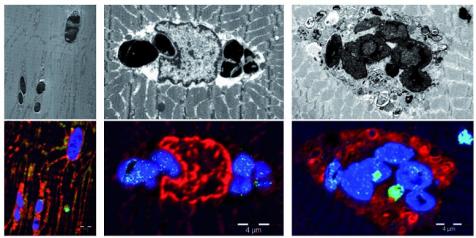
Institute (IDIBELL) led by Dr. Montse Olivé have described in Nature Communications a new muscular disease caused by a mutation in the myoglobin gene. The study has been possible thanks to a collaboration with a group of geneticists from the University of Western Australia (UWA), led by Prof. Nigel Laing, and researchers from the Karolinska Institute (Stockholm, Sweden).
Credit: Bellvitge Biomedical Research Institute (IDIBELL)
Breast Is Best - But Don’t Stress
March 28, 2019: James Cook University, QLD.
New research has cast doubt on medical advice commonly given to pregnant women with diabetes.
James Cook University’s Professor Clare Heal says pregnant women with diabetes are encouraged to express milk before their baby is born. “The first secretion from the mammary glands shortly before and after giving birth is colostrum, which is rich in antibodies and proteins.
“Pregnant women with diabetes are encouraged to express and store colostrum before they have their baby for its perceived benefits to the newborn, especially its role in reducing neonatal hypoglycemia,” said Professor Heal.
She said hypoglycemia is a condition where blood sugar decreases to below normal levels.
“Thirteen percent of pregnant women in Australia have diabetes and somewhere between quarter and half of babies born to them have hypoglycaemia – which is associated with cardiorespiratory disturbances, damage to the central nervous system and developmental delay,” she said.
In a study led by JCU’s Dr Jordan Casey, scientists looked at the records of 357 women who had diabetes during their pregnancy.
“There were no significant differences in the rates of hypoglycemia, or median blood glucose levels in babies born to mothers who expressed antenatal colostrum compared to babies born to mothers who did not express,” said Professor Heal.
She said that the practice of collecting colostrum is widely promoted by midwives, diabetes educators and obstetricians. But diabetic women who are unable to collect colostrum can experience increased stress, frustration and a sense of failure, in addition to the stress and guilt they may feel due to the increased risk their condition poses to their baby.
“More research is required to determine if antenatal expression has an overall positive effect on this group of women. Breast feeding is best, and the positive side of expressing in pregnancy is that the baby was less likely to receive formula in hospital, but we shouldn’t pressure women into doing it,” said Professor Heal.
She said that healthcare professionals and others should be kind to pregnant women because it was a stressful time anyway, but also encourage them to be kind to themselves.
“Our study has shown that expressing colostrum antenatally probably makes no difference to baby’s health. It does lead to the baby being more likely to be breastfed, which is great, but women shouldn’t beat themselves up if they can’t do it.”
In The Tree Of Life, Youth Has Its Advantages
March 26, 2019
It's a question that has captivated naturalists for centuries: Why have some groups of organisms enjoyed incredibly diversity -- like fish, birds, insects -- while others have contained only a few species -- like humans.
Researchers trying to explain why the Tree of Life is so unbalanced have agreed on a few explanations -- a species' ability to change colour, its body size, and how it interacts with its environment all influence how quickly it can form new species compared to other organisms.
Geological age has also been a major explanation -- older groups of organisms have had more time to accumulate more species.
But new research in the Proceedings of the National Academy of Sciences shows the passage of time has a surprising, and consistent impact on evolutionary diversity -- and might favour young species.
"If you look at rates of macroevolutionary diversification across 3.8 billion years, it's younger groups of organisms, on average, that accumulate diversity much more quickly than older groups," says Matthew Pennell, an evolutionary biologist at the University of British Columbia and senior author on the paper.
"This suggest that there are some time-dependant, hidden general principles governing how life diversifies on Earth -- operating underneath all the other factors we typically think determine how quickly species diversify or go extinct."
The researchers estimated specification and extinction rates across almost 25,000 branches of multicellular organisms, using data from studies of over 100 groups of species and an independent data set of fossil time series. That enabled them to compare rates of diversification broadly over time. For example cichlids (a species of fish) from African rift lakes are diversifying incredibly fast, while whales are an example of a group that appear to be far past their prime in terms of diversity.
"If groups of species were simply reaching equilibrium and slowing down over time, we'd expect a more consistent pattern of slowing within every group we look at," says Pennell. "But our results aren't showing that."
When the researchers looked at individual groups, rates of diversification varied dramatically. What they did find at the macro-level was a strong pattern of faster growth of diversity in younger groups of species.
"This really throws a wrench in how we interpret how life diversified on Earth," says Pennell.
Evolutionary biologists have tended to look at particular features that have helped particular groups of animals diversify -- or not.
"The far less explored, and potentially more interesting question, is why, despite all the complexity involved in the evolution of new species, that process looks so similar across the Tree of Life."
L. Francisco Henao Diaz, Luke J. Harmon, Mauro T. C. Sugawara, Eliot T. Miller, Matthew W. Pennell. Macroevolutionary diversification rates show time dependency. Proceedings of the National Academy of Sciences, 2019; 201818058 DOI: 10.1073/pnas.1818058116

Children Develop PTSD When They Ruminate Over Their Trauma
March 26, 2019
Children are more likely to suffer Post Traumatic Stress Disorder (PTSD) if they think their reaction to traumatic events is not 'normal' -- according to new research from the University of East Anglia.
While most children recover well after a traumatic event, some go on to develop PTSD that may stay with them for months, years, or even into adulthood.
A new study, published today, reveals that children begin down this route when they have trouble processing their trauma and perceive their symptoms as being a sign that something is seriously wrong.
Lead researcher Prof Richard Meiser-Stedman, from UEA's Norwich Medical School, said: "Symptoms of PTSD can be a common reaction to trauma in children and teenagers. These can include distressing symptoms like intrusive memories, nightmares and flashbacks. Health professionals steer away from diagnosing it in the first month after a trauma because, rather than being a disorder, it's a completely normal response.
"Many children who experience a severe traumatic stress response initially can go on to make a natural recovery without any professional support. But a minority go on to have persistent PTSD, which can carry on for much longer.
"We wanted to find out more about why some children have significant traumatic stress symptoms in the days and weeks after a trauma and while others do not, and importantly -- why some recover well without treatment, while others go on to experience more persistent problems."
The research team worked with over 200 children aged between eight and 17 who had attended a hospital emergency department following a one-off traumatic incident. These included events such as car crashes, assaults, dog attacks and other medical emergencies.
These young people were interviewed and assessed for PTSD between two and four weeks following their trauma, and again after two months.
The research team split the children's reactions into three groups -- a 'resilient' group who did not develop clinically significant traumatic stress symptoms at either time point, a 'recovery' group who initially displayed symptoms but none at the two month follow up, and a 'persistent' group who had significant symptoms at both time points.
The team also examined whether social support and talking about the trauma with friends or family may be protective against persistent problems after two months. They also took into account factors including other life stressors and whether the child was experiencing on-going pain.
Dr Meiser-Stedman said: "We found that PTSD symptoms are fairly common early on -- for example between two and four weeks following a trauma. These initial reactions are driven by high levels of fear and confusion during the trauma.
"But the majority of children and young people recovered naturally without any intervention.
"Interestingly the severity of physical injuries did not predict PTSD, nor did other life stressors, the amount of social support they could rely on, or self-blame.
"The young people who didn't recover well, and who were heading down a chronic PTSD track two months after their trauma, were much more likely to be thinking negatively about their trauma and their reactions -- they were ruminating about what happened to them.
"They perceived their symptoms as being a sign that something was seriously and permanently wrong with them, they didn't trust other people as much, and they thought they couldn't cope.
"In many cases, more deliberate attempts to process the trauma -- for example, trying to think it through or talk it through with friends and family -- were actually associated with worse PTSD. The children who didn't recover well were those that reported spending a lot of time trying to make sense of their trauma. While some efforts to make sense of trauma might make sense, it seems that it is also possible for children to get 'stuck' and spend too long focusing on what happened and why.
"The young people who recovered well on the other hand seemed to be less bothered by their reactions, and paid them less attention."
The project was funded by the Medical Research Council, and led by researchers at UEA and the University of Cambridge. It was carried out in collaboration with Macquarie University in Australia, Sussex Partnership NHS Foundation Trust, Addenbrooke's Hospital in Cambridge, Kings College London and the Cambridgeshire and Peterborough NHS Foundation Trust.
Richard Meiser‐Stedman, Anna McKinnon, Clare Dixon, Adrian Boyle, Patrick Smith, Tim Dalgleish. A core role for cognitive processes in the acute onset and maintenance of post‐traumatic stress in children and adolescents. Journal of Child Psychology and Psychiatry, 2019; DOI: 10.1111/jcpp.13054
Disclaimer: These articles are not intended to provide medical advice, diagnosis or treatment. Views expressed here do not necessarily reflect those of Pittwater Online News or its staff.